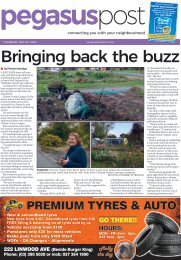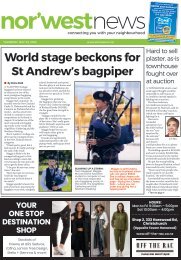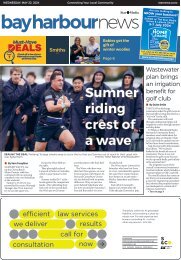Bay Harbour: December 06, 2023
You also want an ePaper? Increase the reach of your titles
YUMPU automatically turns print PDFs into web optimized ePapers that Google loves.
Wednesday <strong>December</strong> 6 <strong>2023</strong> <strong>Bay</strong> <strong>Harbour</strong> News<br />
TREASURES FROM THE PAST 27<br />
Figureheads and good fortune<br />
THIS FINE female figurehead<br />
from the barque Raupo is typical<br />
of 19th century clipper ships<br />
whose bows were often adorned<br />
with elaborate carvings, which<br />
were both an identifier and a<br />
talisman for good fortune.<br />
Across cultures and centuries<br />
practices of decorating a vessel<br />
served multiple symbolic,<br />
patriotic and religious purposes.<br />
From as early as 3000BC<br />
Egyptian barges were painted<br />
with the protective ‘Eye of<br />
Horus’. The bows of Greek<br />
and Phoenician galleons also<br />
sported pairs of painted eyes,<br />
or ferocious boars heads or<br />
swift horses. Roman warships<br />
(naves longae in Latin, from<br />
whence the english word ‘navy’<br />
derives) featured valourious<br />
centurions. On Viking longships,<br />
through AD 800-1100, dragons<br />
or serpents snarled from high<br />
prows. And in the mid 18th-19th<br />
centuries Burmese royal barges<br />
carried figureheads of important<br />
mythical characters.<br />
Throughout Polynesia and in<br />
Aotearoa New Zealand, waka<br />
horua (ocean going canoes),<br />
waka ama (outrigger canoes)<br />
and waka taua (war canoes) had<br />
intricate, perforated, spiral carvings<br />
supporting a carved tauihu<br />
(prow).<br />
On smaller fishing vessels<br />
called waka tētē (or waka pakoko)<br />
figureheads often took the<br />
form of a stylised face with a protruding<br />
tongue. In 2011, remains<br />
of a carved waka found near the<br />
Anaweka estuary in the Tasman<br />
District were radiocarbon dated<br />
to about 1400.<br />
In the 17th and 18th centuries<br />
English vessels carried<br />
figureheads representing saints,<br />
historical figures, a ship’s owner<br />
or royal patron, naval leaders,<br />
Figurehead of coal hulk Raupo in Lyttelton, 1930-1939. Te Ūaka The Lyttelton Museum ref 11326.1 https://www.teuaka.org.<br />
nz/online-collection/1131766 Left – Carved wooden figurehead from a French vessel, ref 2.1 https://www.teuaka.org.nz/<br />
online-collection/469965. Male figurehead from a British ship, ref 336.1 https://www.teuaka.org.nz/online-collection/531484<br />
or emblematic animals such as<br />
unicorns and lions. They served<br />
as both signifiers of origin and<br />
demonstrations of financial and<br />
imperial might. However, the<br />
weight of these large wooden<br />
carvings mounted on the tip of<br />
the hull could cause problems<br />
with a ship’s manoeuvrability.<br />
A move to three quarter rather<br />
than full-sized figures made of<br />
lighter woods like pine, rather<br />
than the oak traditionally used,<br />
went some way to addressing<br />
that issue.<br />
With the burgeoning of<br />
merchant sailing in the 1850s,<br />
the structure of the new clipper<br />
ships bows allowed the mounting<br />
of full size figureheads. The<br />
vast majority were female figures<br />
– they not only symbolically<br />
represented the ‘eyes’ of the ship<br />
watching out for the perils of the<br />
wide ocean, but also the intrinsic<br />
spirit of the vessel.<br />
In maritime tradition ships<br />
had long been referred to as<br />
‘she’ in reference to women’s<br />
beauty and grace being reflected<br />
in a vessel’s elegant curves and<br />
movements, and to represent the<br />
powers of nurturing, protection<br />
and support. Many figureheads<br />
were bare breasted to emphasise<br />
these feminine qualities.<br />
There is a certain irony that<br />
maritime superstition had it a<br />
woman on board was unlucky,<br />
causing distraction, and even<br />
inciting ‘Mother Nature’ to ‘take<br />
revenge’. Ordinary seaman,<br />
working in what was a truly<br />
perilous profession, embraced<br />
these long-held traditions and<br />
superstitions. Men grew to love<br />
their ships and the figurehead<br />
particularly was something they<br />
were proud to take care of.<br />
As to the Raupo’s history, at<br />
the time of her construction<br />
in 1876 by John Key and Sons<br />
at Abden shipyard in Dundee,<br />
Scotland, the 682 tonne ironhulled<br />
barque was registered<br />
as the Peru. Purchased by<br />
J.J Craig in 1907 for moving<br />
cargo between Aotearoa New<br />
Zealand and Australia, she was<br />
renamed Louisa Craig.<br />
In 1916, her name and ownership<br />
changed again when she<br />
was bought by George Scales of<br />
Wellington, renamed Raupo, and<br />
used to ply the Tasman transporting<br />
timber and coal. She<br />
also made five voyages to San<br />
Francisco carrying raupō (flax),<br />
hemp and kauri gum, returning<br />
with a hold full of cased oil.<br />
In 1922, the Canterbury Steam<br />
Navigation Company bought<br />
the Raupo and towed her to<br />
Whakaraupō Lyttelton <strong>Harbour</strong>,<br />
where she spent her last years in<br />
use as a coal hulk. In 1937, she<br />
was stripped down to the waterline<br />
and beached at the ‘ships’<br />
graveyard’ off Otamahua Quail<br />
Island. Between 1902 and 1953<br />
a total of 13 vessels were laid<br />
to rest there, out of the way of<br />
the harbour’s busy navigation<br />
channels.<br />
Where the Raupo’s darkhaired<br />
figurehead ended up is<br />
unknown, however Te Uaka’s<br />
collection holds two other fine<br />
examples – a crowned woman<br />
garbed in blue from a French<br />
vessel and a British naval<br />
gentleman resplendent with<br />
brass buttons and epaulettes.<br />
Join the rebuild<br />
Enjoying the regular stories from our collection?<br />
Just imagine what we could offer with a physical<br />
Museum!<br />
Your donation can help make it a reality.<br />
Please consider donating today<br />
www.teuaka.org.nz/donate OR scan here ><br />
to donate your chosen amount


















